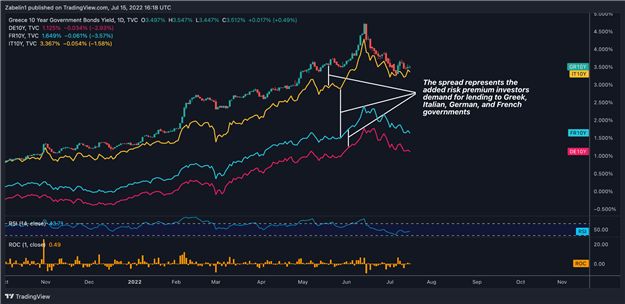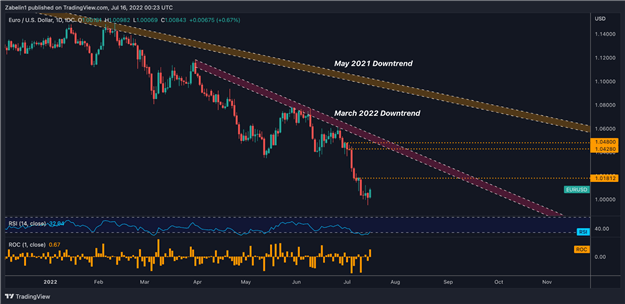EURO, US DOLLAR, EUR/USD, ECB RATE DECISION, NORD STREAM 1 - TALKING POINTS
- Euro slide against US Dollar could continue despite anticipations of ECB rate hike
- Uncertainty about Nord Stream 1 and its reopening may amplify regional volatility
- EUR/USD descent could experience a brief pause. Upside path remains daunting



ECB RATE DECISION
Interest rate futures show investors are anticipating the European Central Bank (ECB) will raise rates for the first time in 10 years this week. While a 25-basis point rate hike is meaningful, the benchmark EONIA (the interest rate for one-day loans between European banks, akin to the US Federal Funds rate) would still be in negative territory.
Inflation on a year-on-year basis for June registered at 8.1%, a record high. It is being amplified by the war in Ukraine. Consequently, the ECB – and most central banks across the world – are gearing up to tighten credit conditions amid a broad-based surge in price growth. It appears that a combination of both demand-pull and cost-push forces are at play – read more here.
Furthermore, the ECB is also expected to unveil a new toolkit to prevent severe divergences in borrowing costs among Eurozone member states. The objective: to smooth out the structurally embedded asymmetry in the results of monetary policy implementation across the currency bloc.
These tend be especially troubling during times of economic and financial distress and can be seen by the yield differential between states such as Italy and Germany. These spreads widened significantly during the 2008 financial crisis, the follow-on Eurozone debt crisis, Italian political turmoil in 2018, and at the start of the Covid-19 pandemic in 2020.
Greek, Italian, German, and French Bond Yields - Daily Chart

Chart created using TradingView
When sentiment is upbeat and investors are orienting their strategies around yield maximization, sovereign bond yields across Eurozone countries frequently converge. What is being shown now is the opposite: credit conditions are tightening, geopolitical tension is high along with inflation, and the economic outlook appears increasingly dim (with downgraded growth projections).
The instrument to be used to manage the problem is known as the “Transmission Protection Mechanism” (TPM). However, many obstacles remain. An effort to reel in “excessive” spreads – what that means exactly is unclear – could create a moral hazard for vulnerable countries. This may be especially so for Mediterranean states, who have for the past decade carried a higher risk premium in their sovereign bond yields.
These Eurozone members may increase bond issuance, knowing that the ECB would be “capping their spreads”. This could indirectly constitute monetary financing, a policy protocol that is prohibited under the Maastricht treaty. So, legal roadblocks may be an inhibiting factor to this new monetary policy tool.
With so much uncertainty in already macroeconomically-precarious times, the Euro could be in for a ride. Implied volatility for a one-week period against the US Dollar shows the European currency in third place behind the commodity-linked (and less liquid) Norwegian Krone and Swedish Krona.
That the Euro is in such close proximity – on an expected volatility basis – to currencies that are known to oscillate frequently with overall sentiment underscores the importance of the week ahead. A hike is already priced in, so the source of volatility will likely come from the press conference with ECB President Christine Lagarde after the announcement, with special emphasis on any comments that speak to fragmentation and the TPM.
NORD STREAM 1 PIPELINE
Also on the inflation front, there is concern among European policymakers that scheduled maintenance of the Nord Stream 1 pipeline may keep Russian gas valves closed. Moscow stated that the pipeline has been operating at 40% capacity due to a missing piece of critical infrastructure (a turbine) that is being repaired in Canada.
European policymakers are concerned that the reopening of Nord Stream 1 could be delayedin response to the Western-led sanctions. The result could mean rationing natural gas for Europeans, which could in turn set the stage for political and social unrest against the backdrop of tightening credit conditions regionally and globally.
This could curb Euro enthusiasm for a recovery. However, that will likely depend on how the ECB articulates how far it is willing to go to bring down inflation. Markets will look to gauge whether policymakers are determined, echoing the “whatever it takes” approach to containing the mid-2010s debt crisis, or flexible enough to slow down or abort tightening if the economy buckles.
If it seems more so the former, the Euro may briefly catch a break. If it is the latter, the currency may continue to tumble, particularly against the US Dollar. The Fed has made it clear that it is going to hike rates to bring inflation down, and a stock market selloff has not appeared to erode its conviction.
Introduction to Technical Analysis
Learn Technical Analysis
Recommended by Dimitri Zabelin
EUR/USD TECHNICAL ANALYSIS
EUR/USD began its latest descent around May 2021, with the incline of depreciation steepening in March 2022. Since the start of the latter, the pair has fallen almost 10%, putting the cumulative decline at around 18%. With EUR/USD having recently reached parity for the first time since the early 2000s, identifying technical support levels has become more difficult.
EUR/USD - Daily Chart

EUR/USD chart created using TradingView
Pinpointing potential resistance yields more fruitful insights. Three former support levels have emerged that might offer a degree of friction for EUR/USD on an attempt to recover. They are 1.0480, 1.0428, and 1.0181, respectively.
If the pair is able to stage a rebound, clearing 1.0181 will be the first test of resolve. Beyond that, clearing descending resistance will be critical, and doing so could indicate a medium-term reversal. Optimism from there may then lead EUR/USD to retest the 1.0480 -1.0428 bound. Buyers may then turn apprehensive at that threshold.





